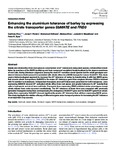Use este identificador para citar ou linkar para este item:
http://www.alice.cnptia.embrapa.br/alice/handle/doc/1007369Registro completo de metadados
| Campo DC | Valor | Idioma |
|---|---|---|
| dc.contributor.author | ZHOU, G. | pt_BR |
| dc.contributor.author | PEREIRA, J. F. | pt_BR |
| dc.contributor.author | DELHAIZE, E. | pt_BR |
| dc.contributor.author | ZHOU, M. | pt_BR |
| dc.contributor.author | MAGALHAES, J. V. | pt_BR |
| dc.contributor.author | RYAN, P. R. | pt_BR |
| dc.date.accessioned | 2015-01-30T11:11:11Z | pt_BR |
| dc.date.available | 2015-01-30T11:11:11Z | pt_BR |
| dc.date.created | 2015-01-30 | pt_BR |
| dc.date.issued | 2014 | pt_BR |
| dc.identifier.citation | Journal of Experimental Botany, London, v. 65, n. 9, p. 2381-2390, 2014. | pt_BR |
| dc.identifier.uri | http://www.alice.cnptia.embrapa.br/alice/handle/doc/1007369 | pt_BR |
| dc.description | Malate and citrate efflux from root apices is a mechanism of Al3+ tolerance in many plant species. Citrate efflux is facilitated by members of the MATE (multidrug and toxic compound exudation) family localized to the plasma membrane of root cells. Barley (Hordeum vulgare) is among the most Al3+-sensitive cereal species but the small genotypic variation in tolerance that is present is correlated with citrate efflux via a MATE transporter named HvAACT1. This study used a biotechnological approach to increase the Al3+ tolerance of barley by transforming it with two MATE genes that encode citrate transporters: SbMATE is the major Al3+-tolerance gene from sorghum whereas FRD3 is involved with Fe nutrition in Arabidopsis. Independent transgenic and null T3 lines were generated for both transgenes. Lines expressing SbMATE showed Al3+-activated citrate efflux from root apices and greater tolerance to Al3+ toxicity than nulls in hydroponic and short-term soil trials. Transgenic lines expressing FRD3 exhibited similar phenotypes except citrate release from roots occurred constitutively. The Al3+ tolerance of these lines was compared with previously generated transgenic barley lines overexpressing the endogenous HvAACT1 gene and the TaALMT1 gene from wheat. Barley lines expressing TaALMT1 showed significantly greater Al3+ tolerance than all lines expressing MATE genes. This study highlights the relative efficacy of different organic anion transport proteins for increasing the Al3+ tolerance of an important crop species. | pt_BR |
| dc.language.iso | eng | eng |
| dc.rights | openAccess | eng |
| dc.subject | Citrato | pt_BR |
| dc.subject | Tolerância ao alumínio | pt_BR |
| dc.subject | Transgênico | pt_BR |
| dc.title | Enhancing the aluminium tolerance of barley by expressing the citrate transporter genes SbMATE and FRD3. | pt_BR |
| dc.type | Artigo de periódico | pt_BR |
| dc.date.updated | 2015-02-01T11:11:11Z | pt_BR |
| dc.subject.thesagro | Cevada | pt_BR |
| dc.subject.thesagro | Solo Ácido | pt_BR |
| riaa.ainfo.id | 1007369 | pt_BR |
| riaa.ainfo.lastupdate | 2015-02-01 | pt_BR |
| dc.identifier.doi | 10.1093/jxb/eru121 | pt_BR |
| dc.contributor.institution | UNIVERSITY OF TASMANIA; JORGE FERNANDO PEREIRA, CNPT; CSIRO PLANT INDUSTRY; UNIVERSITY OF TASMANIA; JURANDIR VIEIRA DE MAGALHAES, CNPMS; CSIRO PLANT INDUSTRY. | pt_BR |
| Aparece nas coleções: | Artigo em periódico indexado (CNPT)  | |
Arquivos associados a este item:
| Arquivo | Descrição | Tamanho | Formato | |
|---|---|---|---|---|
| 2014JournalofExperimentalBotanyv65n9p2381.pdf | 1.87 MB | Adobe PDF |  Visualizar/Abrir |









